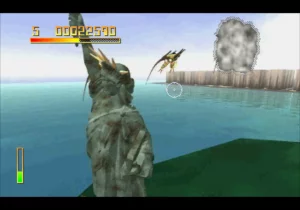Chaos Control

Description
Chaos Control for the SEGA Saturn, released in 1995, stands as an interesting artifact from a bygone era of gaming. This full-motion video (FMV) rail shooter endeavored to push the boundaries of what home consoles could achieve in terms of cinematic presentation, but the execution leaves much to be desired.
The game places players in the role of Jessica Darkhill, a pilot tasked with thwarting an alien invasion in a futuristic setting. The plot is thin and somewhat derivative, borrowing heavily from popular science fiction tropes of its time. However, the story's primary role is simply to set the stage for the frenetic shooting action that ensues. While the narrative won't win any awards for originality or depth, it does an adequate job of motivating players to continue pressing forward.
At its core, Chaos Control is an on-rails shooter, a genre that was relatively popular in the mid-90s but has since fallen out of favour. The gameplay involves guiding a targeting reticle around pre-rendered video backdrops, shooting at a slew of enemy crafts and projectiles. While this might sound simple enough, the real challenge of the game comes from the sheer volume of objects that need to be shot down while avoiding incoming fire. For fans of the genre, the action can be quite engaging, if a bit repetitive over extended play sessions.
Graphically, Chaos Control was ambitious for its time. Featuring pre-rendered 3D environments and FMV sequences, the game aimed to deliver a visually striking experience. Unfortunately, the graphical fidelity does not hold up well by modern standards. The video quality is grainy and pixelated, a limitation of the SEGA Saturn's hardware and the technology available at the time. While it may have been visually impressive upon release, today's players might find it jarring and difficult to appreciate.
The audio experience in Chaos Control is a mixed bag. The soundtrack, composed of synthesizer-heavy tunes, matches the high-octane action well and adds a sense of urgency to the gameplay. However, the voice acting and sound effects are less impressive. The dialogue is often stilted and delivered without much emotion, detracting from the overall immersion. Sound effects, particularly the constant barrage of laser fire and explosions, can grow tiresome and grating on the ears during longer play sessions.
Control-wise, the game is functional but lacks precision. The SEGA Saturn's controller is not necessarily the most adept input device for an on-rails shooter, making targeting feel somewhat imprecise at times. The on-screen reticle occasionally lags behind player inputs, which can lead to frustrations during the more hectic parts of the game. Despite these control issues, the game is still playable and can be quite enjoyable for those who are persistent and adjust to its quirks.
In the end, Chaos Control is a title best appreciated as a piece of gaming history rather than a timeless classic. It epitomizes the experimental spirit of the mid-90s gaming industry, where developers were eager to explore new technologies and storytelling methods. For collectors or fans of the SEGA Saturn looking to experience every facet of the console's library, Chaos Control offers a glimpse into an era of ambition and innovation, albeit with its fair share of flaws. For the modern gamer, however, its rough edges and dated presentation make it more of a curiosity than a must-play.
Leave a Reply
Related games
Battle Arena Toshinden Ultimate Revenge Attack
by NexTech Corporation, 1996





















